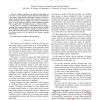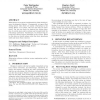1281 search results - page 57 / 257 » Software Visualization for Reverse Engineering |
WCRE
2000
IEEE
14 years 1 months ago
2000
IEEE
Component recovery supports program understanding, architecture recovery, and re-use. Among the best known techniques for detection of re-usable objects (related global variables ...
WCRE
2009
IEEE
14 years 3 months ago
2009
IEEE
Abstract—Change coupling is the implicit relationship between two or more software artifacts that have been observed to frequently change together during the evolution of a softw...
WCRE
2003
IEEE
14 years 2 months ago
2003
IEEE
The process of software reverse engineering commonly uses an extractor, which parses source code and extracts facts about the code. The level of detail in these facts varies from ...
MSR
2006
ACM
14 years 2 months ago
2006
ACM
Refactorings are program transformations which should preserve the program behavior. Consequently, we expect that during phases when there are mostly refactorings in the change hi...
INDIASE
2009
ACM
14 years 3 months ago
2009
ACM
When trying to reverse engineer software, execution trace analysis is increasingly used. Though, by using this technique we are quickly faced with an enormous amount of data that ...


